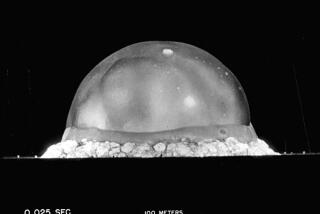‘Anthropocene’ epoch for Earth etches human impacts in stone

Man’s tenure on Earth is brief on the astronomical time scale, but the changes wrought by Homo sapiens have been measurable and profound.
Now, a growing number of scientists propose renaming the present geologic epoch to reflect that human influence: the Anthropocene.
The revision of geology’s official time scale would be more than nominal. On a philosophical level, it would place mankind back at the center of his world, though cast as a villain who has manipulated the course of
natural history by pushing other species to extinction and altering the chemical and physical composition of the atmosphere and oceans.
“Formally defining the Anthropocene would state that humans are a force of nature at a geological scale, equivalent to plate tectonics or a meteorite strike, or sustained volcanic eruptions,” said Simon Lewis, an ecologist at University College in London who made the case for the name change this week in the journal Nature.
“It changes almost 500 years of scientific understanding, which has pushed humans to become more and more insignificant.”
Officially, we’ve been living in the Holocene epoch for the last 11,650 years, when Earth’s last glacial period ended. The label is derived from Greek and means “wholly recent.”
Lewis and his coauthor, University of Leeds geographer Mark Maslin, say the more relevant recent marker came in 1610, when an Antarctic ice core recorded a tiny dip in the amount of carbon dioxide in Earth’s atmosphere. That, they argue, is an inflection point of an ongoing era of intensive human influence on Earth’s biology, geology and chemistry.
By 1610, the arrival of Europeans in the Americas had caused about 50 million deaths due to conflict and disease. Agricultural fields were abandoned, allowing forests, savannas and woodlands to regenerate. Fewer people also meant less intentional burning.
Both of these shifts reduced the amount of carbon dioxide in the atmosphere by about 7 to 10 parts per million, the ice core from Antarctica’s Law Dome indicates.
These changes also came amid a broader trend of human-aided spread of plant species across continents, reflected in pollen deposits across many continents, Lewis and Maslin say.
After colonization of the Americas accelerated, increased trade made the Industrial Revolution possible. Population growth resumed and humans began burning fossil fuels on an unprecedented scale. The amount of carbon dioxide in Earth’s atmosphere has since gone up by more than a third.
The term Anthropocene has been around at least since the 19th century, but it acquired pop culture cachet as concern over climate change mounted. It gained momentum among scientists around 2000, when Nobel laureate Paul Crutzen, an atmospheric chemist, suggested that the start of the Industrial Revolution in the Western world could be a suitable milestone for the new epoch.
Several other scientists who agree that the Anthropocene has arrived have said the boundary should be 1950, when fossil fuel use accelerated. Still others, including Lewis and Maslin, say the 1960s are a strong candidate, due to the radioactive fallout from nuclear bomb testing.
The International Union of Geological Sciences has convened a working group to make a recommendation on whether to call an end to the Holocene and how to define the beginning of the Anthropocene.
The group’s chairman, University of Leicester paleobiologist Jan Zalasiewicz, called the proposed 1610 benchmark “intriguing” and worth consideration by the full panel.
“It’s clearly an important historical event,” said Zalasiewicz, who added
that he was not speaking for the entire working group. “Whether it can provide an effective stratigraphic boundary needs more evidence and further research, I suspect.”
The tiny dip in carbon dioxide, he noted, may be detectable in ice cores, but it doesn’t show up well in other types of strata.
Indeed, critics have essentially cried: Show us the rocks. Modern layers have not fully formed, and there is some doubt whether there will be lasting mineral, chemical and fossil evidence to mark the rock boundary, they argue.
A geologic boundary should be based on more than “hypothetical inferences of what might happen in the future,” said geologist Whitney Autin of the State University of New York College at Brockport.
Ideally, geology’s broad partitions of Earth history are defined by a lower boundary. But transitions can be blurry, because the fossil record is incomplete and there are wide margins of error in dating techniques. Over millions of years, quibbles about a few decades or centuries don’t matter like they do in the present.
A classic example is the extinction of dinosaurs and gradual rise of mammals about 65 million years ago, after an asteroid slammed into the planet. It marks the transition between the Cretaceous and Tertiary periods.
“That’s the long-term change, but the actual marker is the peak in iridium that’s captured in the rocks, which came from the meteorite strike,” Lewis said.
While scientists generally agree on the long-term change being engineered by humans, they are still seeking the equivalent of the iridium trace — sometimes referred to as the “golden spike” in the timeline.
“It would be desirable to have some definition, so some people aren’t using the Anthropocene and talking about 8,000 years ago, and other people are using it and talking about the 1960s,” Lewis said.
In all likelihood, the international working group will vote in favor of adopting the term Anthropocene, Lewis said.
But such a proposal still would have to work its way through many layers of bureaucracy before a vote takes place.
In the meantime, nothing is likely to stem the increased use of the term among scientists, nor end the debate over its definition, Lewis said.
“It’s a good discussion to have, because it helps us step back and think about the really large-scale, long-term impact that our activities can have,” he said. “That’s really important to think about.”
geoffrey.mohan
@latimes.com
Twitter: @LATsciguy







